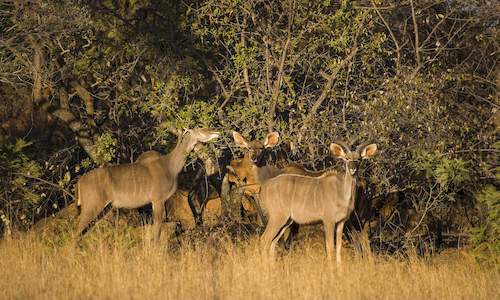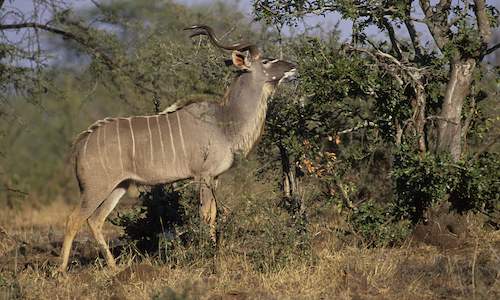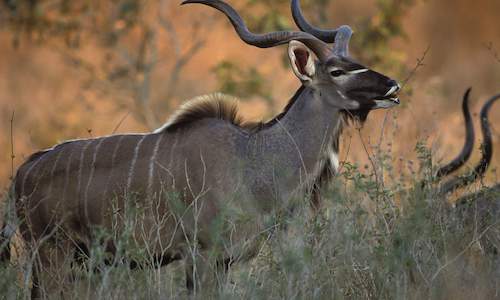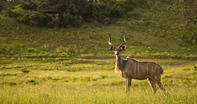
Kudu
Name
Kudu or greater kudu (Tragelaphus strepsiceros).
Appearance
The greater kudu of South Africa has tawny-brown to grey-brown coats with distinctive white stripes running down on its flanks.
They have a white V-shaped band across the eyes and forehead with white spots on their cheeks. There are strong physical differences between males and females. The males grow long, spiral horns that can reach up to 1,8 m in length.
The kudu bull’s horns reach full length at the age of six years old, and males are significantly larger than females.
Bulls can weigh as much as 300 kg with a shoulder height of 1.4 m and cows weigh 210 kg with a shoulder height of 1.25 m. Kudu have long manes of hair that run on its back from head to tail and along the lower neck to the underbelly.
Kudu Diet
The kudu is a browser and feeds on a variety of leaves of trees and shrubs indigenous to South Africa. It also feeds on various fruits, pods, forbs and creepers during different seasons. The kudu is also known to eat South African succulents such as spekboom and aloes.
Kudu Breeding
For male kudu, the rutting season occurs between April and May in South Africa. Newborn calves aged 4-6 weeks old are hidden away and nursed by their mothers who visit. Female kudus and their offspring form small groups of four to ten. Breeding throughout the year is not uncommon.
Kudu Behaviour
A kudu herd tends to split up into two sub-groups. Young females remain with their mothers, while sexually mature males around the age of two years old form bachelor groups. Kudu males will join the female herds during mating season. No territorial spacing exists amongst bulls, but as they show age in their physical appearance, they have size-graded dominant hierarchies.
Kudu Habitat
The kudu prefers to live in dry bushveld environments across South Africa. They can be found in dense bush, wooded foothills of mountain areas, open Knobthorn woodlands in the Kruger National Park and game farms in Mpumalanga. They are also located in the Mopane and Miombo woodlands of the northern and North-western Provinces, and countries further up.
Where They Are Found
The kudu are common game animals found across South Africa. They can be seen in game reserves private game farms and are often seen on regular farms.
Spoor Description
Kudu hooves are 8-9 cm long and pointed in shape, and are similar in length to the blue wildebeest.

Browsers: leaves, herbs, forbs, fruit, flowers, seedpods, succulents, tubers, (new grass)...
more
They are very secretive and tend to freeze if startled allowing their disruptive colouration to blend them into their dappled environment....
more
The male has the most impressive horns of all the African antelope (record 69.3 inches, ave 47 inches) and is larger than the female....
more
 Browsers: leaves, herbs, forbs, fruit, flowers, seedpods, succulents, tubers, (new grass)...
Browsers: leaves, herbs, forbs, fruit, flowers, seedpods, succulents, tubers, (new grass)... They are very secretive and tend to freeze if startled allowing their disruptive colouration to blend them into their dappled environment....
They are very secretive and tend to freeze if startled allowing their disruptive colouration to blend them into their dappled environment.... The male has the most impressive horns of all the African antelope (record 69.3 inches, ave 47 inches) and is larger than the female....
The male has the most impressive horns of all the African antelope (record 69.3 inches, ave 47 inches) and is larger than the female....